Challenges in Year 3 Reading Comprehension: A Literature Review
VerifiedAdded on 2019/12/18
|12
|3637
|181
Literature Review
AI Summary
This literature review examines the challenges of reading comprehension among Year 3 students. It explores the historical background of reading instruction, the importance of reading comprehension, and the factors contributing to students' difficulties in this area. The review analyzes the Daily 5 framework as a potential strategy to improve reading comprehension, highlighting the need for effective literacy programs and structured teaching. It discusses the role of teachers in identifying student weaknesses and implementing appropriate interventions to enhance reading skills and overall learning proficiency. The review critiques the work of educators and policymakers, aiming to determine the effectiveness of strategies, such as The Daily 5 Framework, in improving reading comprehension in Year 3 students performing below the national benchmark. The review covers the importance of reading comprehension, its standards, and how it impacts students' learning abilities. Furthermore, it looks into why students lack the necessary reading comprehension skills, emphasizing the need for tailored interventions and structured teaching to enhance literacy development and improve reading outcomes.
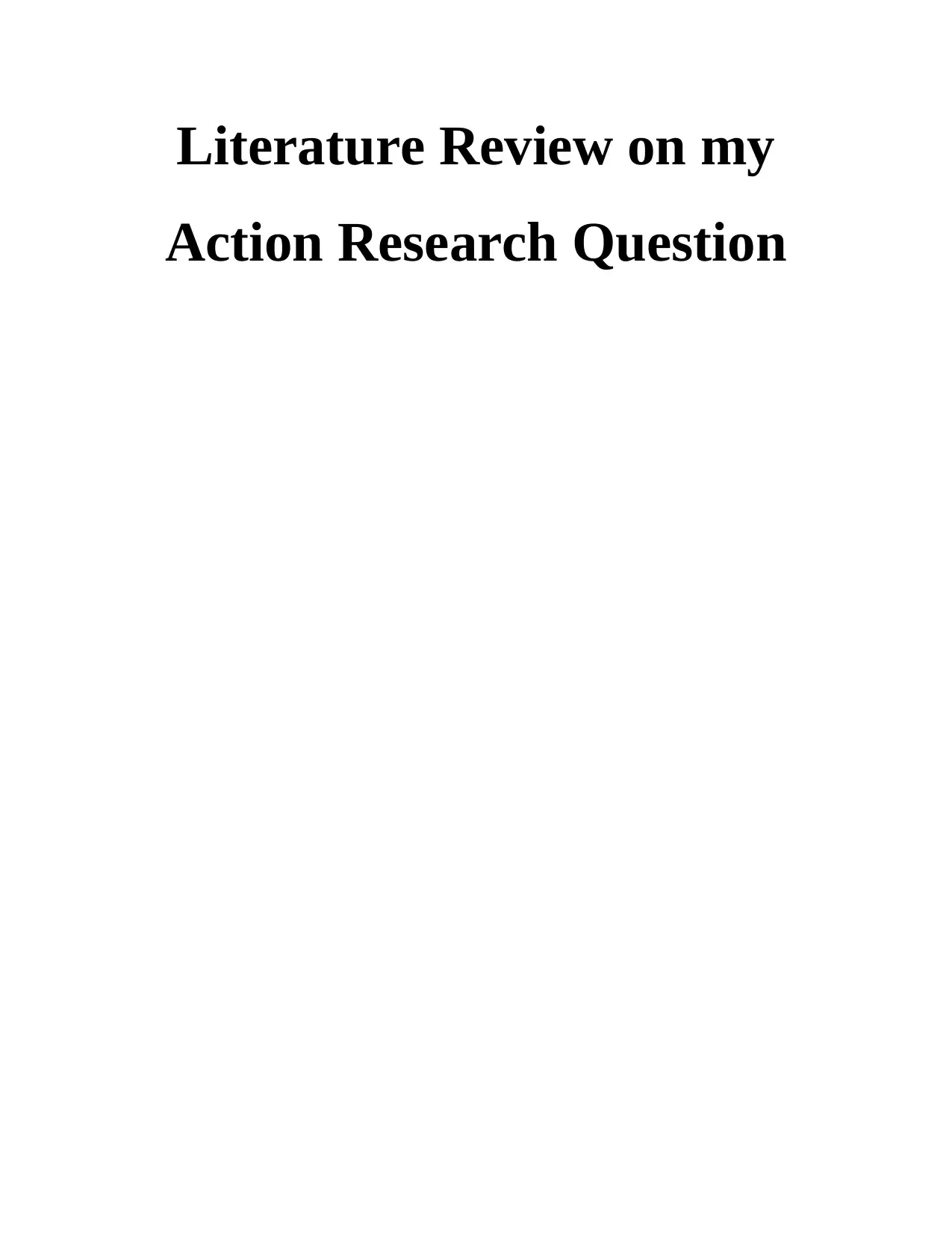
Literature Review on my
Action Research Question
Action Research Question
Paraphrase This Document
Need a fresh take? Get an instant paraphrase of this document with our AI Paraphraser
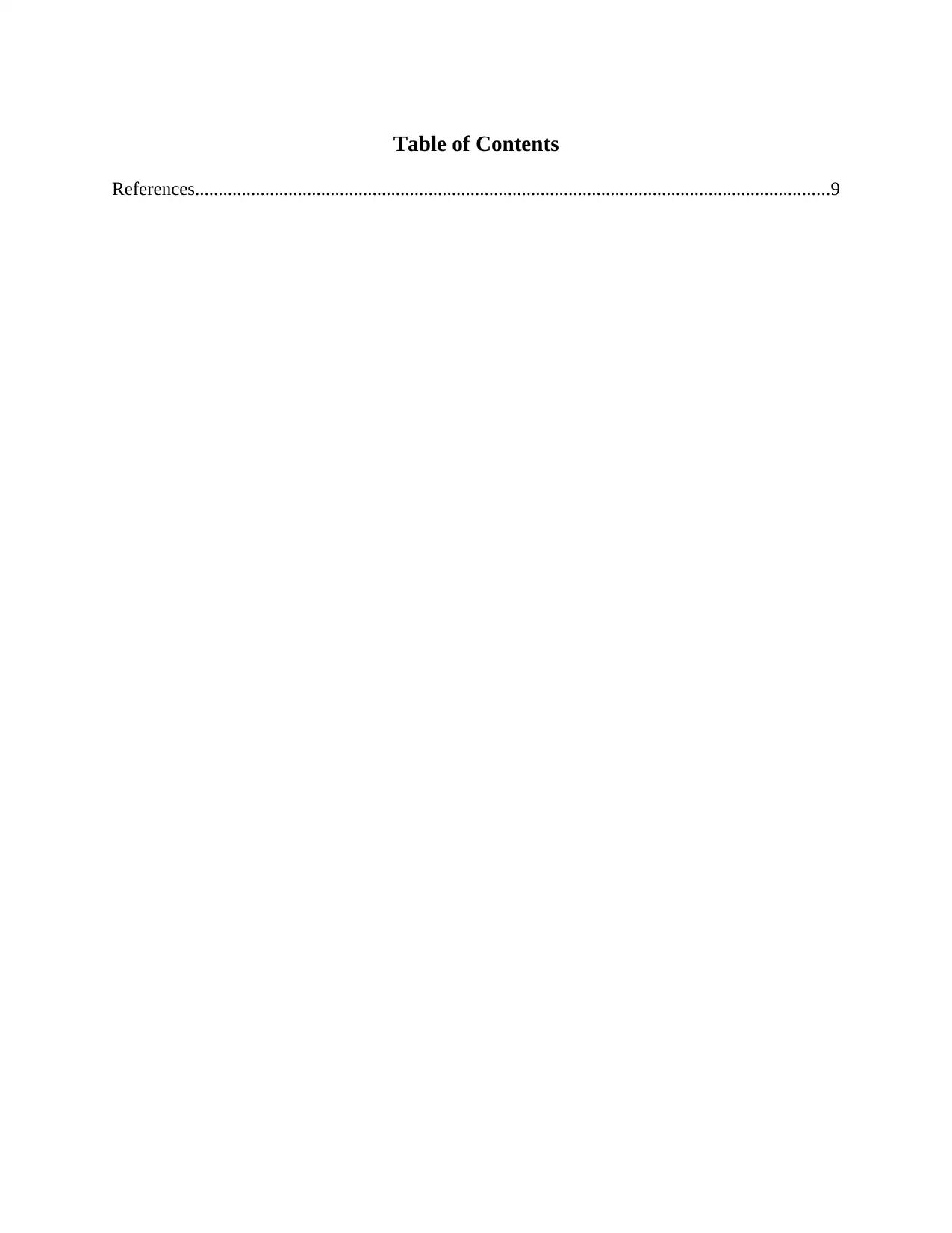
Table of Contents
References........................................................................................................................................9
References........................................................................................................................................9
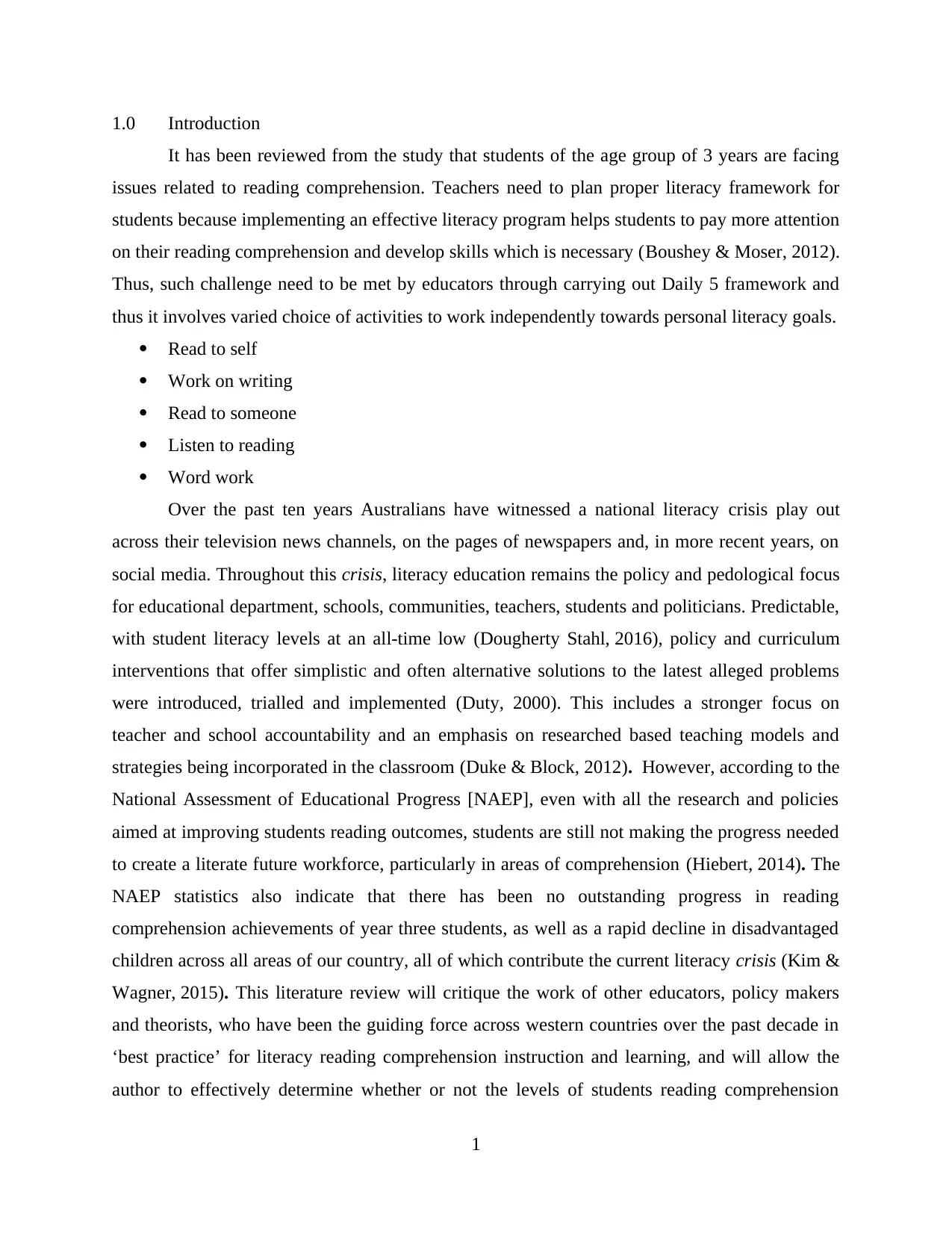
1.0 Introduction
It has been reviewed from the study that students of the age group of 3 years are facing
issues related to reading comprehension. Teachers need to plan proper literacy framework for
students because implementing an effective literacy program helps students to pay more attention
on their reading comprehension and develop skills which is necessary (Boushey & Moser, 2012).
Thus, such challenge need to be met by educators through carrying out Daily 5 framework and
thus it involves varied choice of activities to work independently towards personal literacy goals.
Read to self
Work on writing
Read to someone
Listen to reading
Word work
Over the past ten years Australians have witnessed a national literacy crisis play out
across their television news channels, on the pages of newspapers and, in more recent years, on
social media. Throughout this crisis, literacy education remains the policy and pedological focus
for educational department, schools, communities, teachers, students and politicians. Predictable,
with student literacy levels at an all-time low (Dougherty Stahl, 2016), policy and curriculum
interventions that offer simplistic and often alternative solutions to the latest alleged problems
were introduced, trialled and implemented (Duty, 2000). This includes a stronger focus on
teacher and school accountability and an emphasis on researched based teaching models and
strategies being incorporated in the classroom (Duke & Block, 2012). However, according to the
National Assessment of Educational Progress [NAEP], even with all the research and policies
aimed at improving students reading outcomes, students are still not making the progress needed
to create a literate future workforce, particularly in areas of comprehension (Hiebert, 2014). The
NAEP statistics also indicate that there has been no outstanding progress in reading
comprehension achievements of year three students, as well as a rapid decline in disadvantaged
children across all areas of our country, all of which contribute the current literacy crisis (Kim &
Wagner, 2015). This literature review will critique the work of other educators, policy makers
and theorists, who have been the guiding force across western countries over the past decade in
‘best practice’ for literacy reading comprehension instruction and learning, and will allow the
author to effectively determine whether or not the levels of students reading comprehension
1
It has been reviewed from the study that students of the age group of 3 years are facing
issues related to reading comprehension. Teachers need to plan proper literacy framework for
students because implementing an effective literacy program helps students to pay more attention
on their reading comprehension and develop skills which is necessary (Boushey & Moser, 2012).
Thus, such challenge need to be met by educators through carrying out Daily 5 framework and
thus it involves varied choice of activities to work independently towards personal literacy goals.
Read to self
Work on writing
Read to someone
Listen to reading
Word work
Over the past ten years Australians have witnessed a national literacy crisis play out
across their television news channels, on the pages of newspapers and, in more recent years, on
social media. Throughout this crisis, literacy education remains the policy and pedological focus
for educational department, schools, communities, teachers, students and politicians. Predictable,
with student literacy levels at an all-time low (Dougherty Stahl, 2016), policy and curriculum
interventions that offer simplistic and often alternative solutions to the latest alleged problems
were introduced, trialled and implemented (Duty, 2000). This includes a stronger focus on
teacher and school accountability and an emphasis on researched based teaching models and
strategies being incorporated in the classroom (Duke & Block, 2012). However, according to the
National Assessment of Educational Progress [NAEP], even with all the research and policies
aimed at improving students reading outcomes, students are still not making the progress needed
to create a literate future workforce, particularly in areas of comprehension (Hiebert, 2014). The
NAEP statistics also indicate that there has been no outstanding progress in reading
comprehension achievements of year three students, as well as a rapid decline in disadvantaged
children across all areas of our country, all of which contribute the current literacy crisis (Kim &
Wagner, 2015). This literature review will critique the work of other educators, policy makers
and theorists, who have been the guiding force across western countries over the past decade in
‘best practice’ for literacy reading comprehension instruction and learning, and will allow the
author to effectively determine whether or not the levels of students reading comprehension
1
⊘ This is a preview!⊘
Do you want full access?
Subscribe today to unlock all pages.

Trusted by 1+ million students worldwide
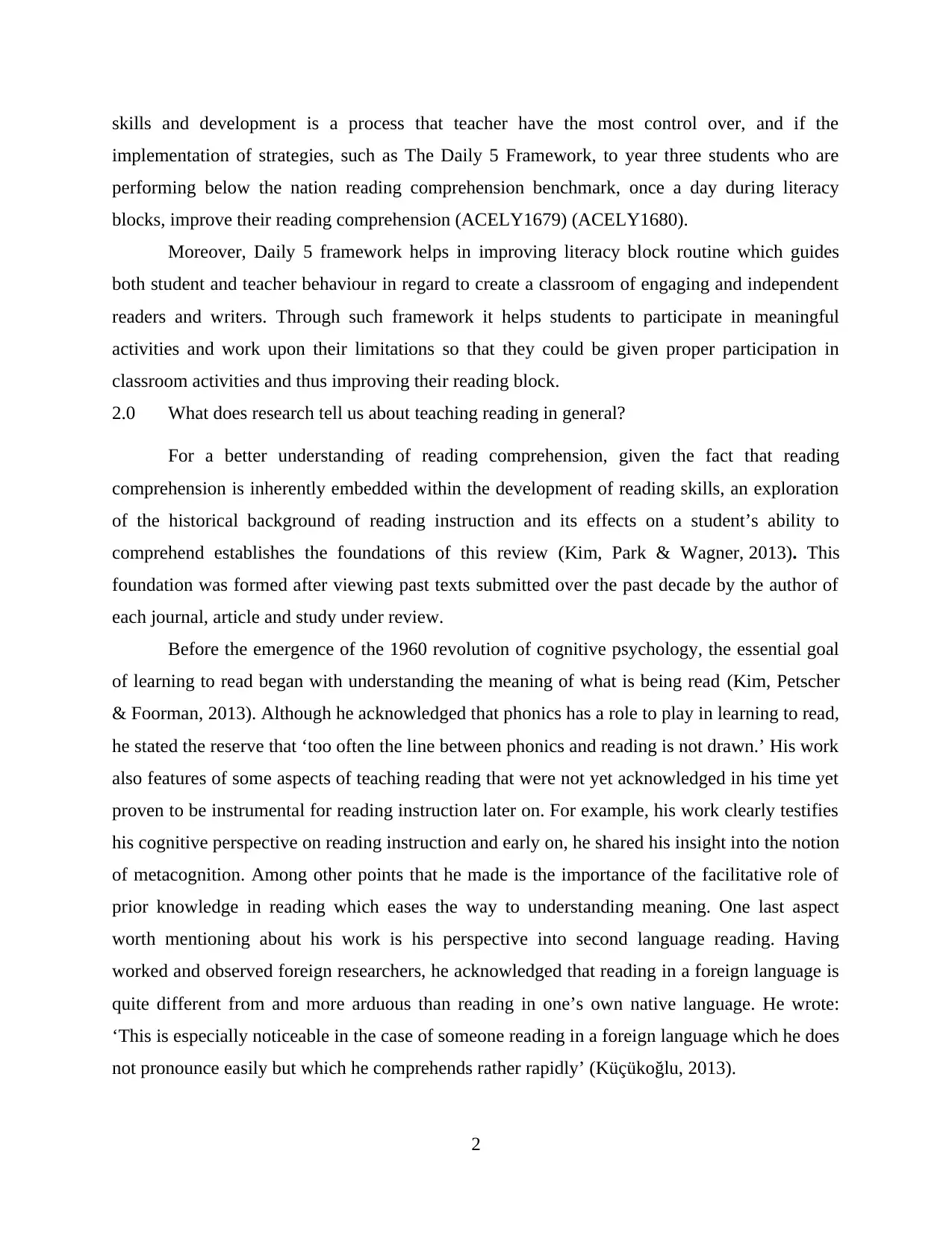
skills and development is a process that teacher have the most control over, and if the
implementation of strategies, such as The Daily 5 Framework, to year three students who are
performing below the nation reading comprehension benchmark, once a day during literacy
blocks, improve their reading comprehension (ACELY1679) (ACELY1680).
Moreover, Daily 5 framework helps in improving literacy block routine which guides
both student and teacher behaviour in regard to create a classroom of engaging and independent
readers and writers. Through such framework it helps students to participate in meaningful
activities and work upon their limitations so that they could be given proper participation in
classroom activities and thus improving their reading block.
2.0 What does research tell us about teaching reading in general?
For a better understanding of reading comprehension, given the fact that reading
comprehension is inherently embedded within the development of reading skills, an exploration
of the historical background of reading instruction and its effects on a student’s ability to
comprehend establishes the foundations of this review (Kim, Park & Wagner, 2013). This
foundation was formed after viewing past texts submitted over the past decade by the author of
each journal, article and study under review.
Before the emergence of the 1960 revolution of cognitive psychology, the essential goal
of learning to read began with understanding the meaning of what is being read (Kim, Petscher
& Foorman, 2013). Although he acknowledged that phonics has a role to play in learning to read,
he stated the reserve that ‘too often the line between phonics and reading is not drawn.’ His work
also features of some aspects of teaching reading that were not yet acknowledged in his time yet
proven to be instrumental for reading instruction later on. For example, his work clearly testifies
his cognitive perspective on reading instruction and early on, he shared his insight into the notion
of metacognition. Among other points that he made is the importance of the facilitative role of
prior knowledge in reading which eases the way to understanding meaning. One last aspect
worth mentioning about his work is his perspective into second language reading. Having
worked and observed foreign researchers, he acknowledged that reading in a foreign language is
quite different from and more arduous than reading in one’s own native language. He wrote:
‘This is especially noticeable in the case of someone reading in a foreign language which he does
not pronounce easily but which he comprehends rather rapidly’ (Küçükoğlu, 2013).
2
implementation of strategies, such as The Daily 5 Framework, to year three students who are
performing below the nation reading comprehension benchmark, once a day during literacy
blocks, improve their reading comprehension (ACELY1679) (ACELY1680).
Moreover, Daily 5 framework helps in improving literacy block routine which guides
both student and teacher behaviour in regard to create a classroom of engaging and independent
readers and writers. Through such framework it helps students to participate in meaningful
activities and work upon their limitations so that they could be given proper participation in
classroom activities and thus improving their reading block.
2.0 What does research tell us about teaching reading in general?
For a better understanding of reading comprehension, given the fact that reading
comprehension is inherently embedded within the development of reading skills, an exploration
of the historical background of reading instruction and its effects on a student’s ability to
comprehend establishes the foundations of this review (Kim, Park & Wagner, 2013). This
foundation was formed after viewing past texts submitted over the past decade by the author of
each journal, article and study under review.
Before the emergence of the 1960 revolution of cognitive psychology, the essential goal
of learning to read began with understanding the meaning of what is being read (Kim, Petscher
& Foorman, 2013). Although he acknowledged that phonics has a role to play in learning to read,
he stated the reserve that ‘too often the line between phonics and reading is not drawn.’ His work
also features of some aspects of teaching reading that were not yet acknowledged in his time yet
proven to be instrumental for reading instruction later on. For example, his work clearly testifies
his cognitive perspective on reading instruction and early on, he shared his insight into the notion
of metacognition. Among other points that he made is the importance of the facilitative role of
prior knowledge in reading which eases the way to understanding meaning. One last aspect
worth mentioning about his work is his perspective into second language reading. Having
worked and observed foreign researchers, he acknowledged that reading in a foreign language is
quite different from and more arduous than reading in one’s own native language. He wrote:
‘This is especially noticeable in the case of someone reading in a foreign language which he does
not pronounce easily but which he comprehends rather rapidly’ (Küçükoğlu, 2013).
2
Paraphrase This Document
Need a fresh take? Get an instant paraphrase of this document with our AI Paraphraser
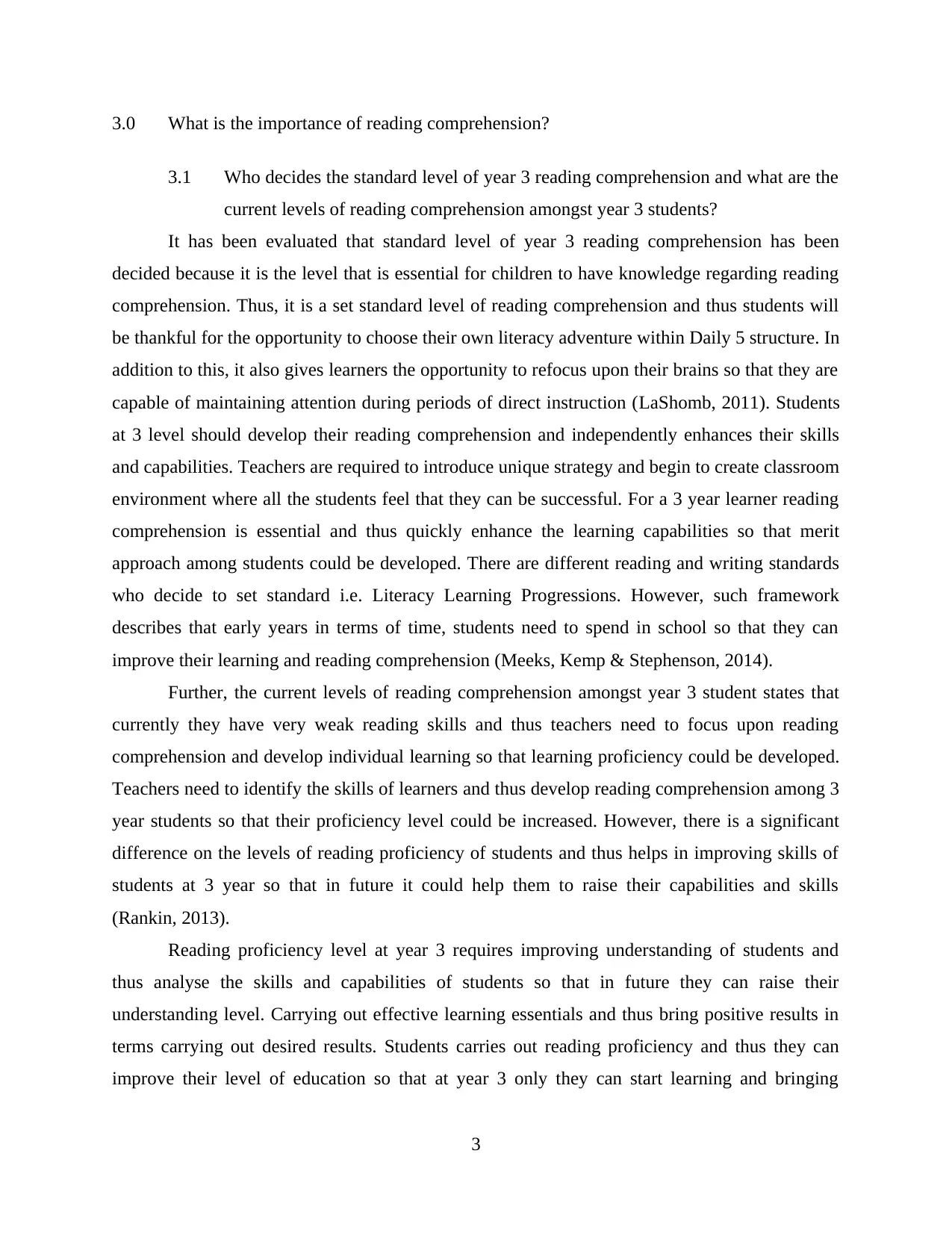
3.0 What is the importance of reading comprehension?
3.1 Who decides the standard level of year 3 reading comprehension and what are the
current levels of reading comprehension amongst year 3 students?
It has been evaluated that standard level of year 3 reading comprehension has been
decided because it is the level that is essential for children to have knowledge regarding reading
comprehension. Thus, it is a set standard level of reading comprehension and thus students will
be thankful for the opportunity to choose their own literacy adventure within Daily 5 structure. In
addition to this, it also gives learners the opportunity to refocus upon their brains so that they are
capable of maintaining attention during periods of direct instruction (LaShomb, 2011). Students
at 3 level should develop their reading comprehension and independently enhances their skills
and capabilities. Teachers are required to introduce unique strategy and begin to create classroom
environment where all the students feel that they can be successful. For a 3 year learner reading
comprehension is essential and thus quickly enhance the learning capabilities so that merit
approach among students could be developed. There are different reading and writing standards
who decide to set standard i.e. Literacy Learning Progressions. However, such framework
describes that early years in terms of time, students need to spend in school so that they can
improve their learning and reading comprehension (Meeks, Kemp & Stephenson, 2014).
Further, the current levels of reading comprehension amongst year 3 student states that
currently they have very weak reading skills and thus teachers need to focus upon reading
comprehension and develop individual learning so that learning proficiency could be developed.
Teachers need to identify the skills of learners and thus develop reading comprehension among 3
year students so that their proficiency level could be increased. However, there is a significant
difference on the levels of reading proficiency of students and thus helps in improving skills of
students at 3 year so that in future it could help them to raise their capabilities and skills
(Rankin, 2013).
Reading proficiency level at year 3 requires improving understanding of students and
thus analyse the skills and capabilities of students so that in future they can raise their
understanding level. Carrying out effective learning essentials and thus bring positive results in
terms carrying out desired results. Students carries out reading proficiency and thus they can
improve their level of education so that at year 3 only they can start learning and bringing
3
3.1 Who decides the standard level of year 3 reading comprehension and what are the
current levels of reading comprehension amongst year 3 students?
It has been evaluated that standard level of year 3 reading comprehension has been
decided because it is the level that is essential for children to have knowledge regarding reading
comprehension. Thus, it is a set standard level of reading comprehension and thus students will
be thankful for the opportunity to choose their own literacy adventure within Daily 5 structure. In
addition to this, it also gives learners the opportunity to refocus upon their brains so that they are
capable of maintaining attention during periods of direct instruction (LaShomb, 2011). Students
at 3 level should develop their reading comprehension and independently enhances their skills
and capabilities. Teachers are required to introduce unique strategy and begin to create classroom
environment where all the students feel that they can be successful. For a 3 year learner reading
comprehension is essential and thus quickly enhance the learning capabilities so that merit
approach among students could be developed. There are different reading and writing standards
who decide to set standard i.e. Literacy Learning Progressions. However, such framework
describes that early years in terms of time, students need to spend in school so that they can
improve their learning and reading comprehension (Meeks, Kemp & Stephenson, 2014).
Further, the current levels of reading comprehension amongst year 3 student states that
currently they have very weak reading skills and thus teachers need to focus upon reading
comprehension and develop individual learning so that learning proficiency could be developed.
Teachers need to identify the skills of learners and thus develop reading comprehension among 3
year students so that their proficiency level could be increased. However, there is a significant
difference on the levels of reading proficiency of students and thus helps in improving skills of
students at 3 year so that in future it could help them to raise their capabilities and skills
(Rankin, 2013).
Reading proficiency level at year 3 requires improving understanding of students and
thus analyse the skills and capabilities of students so that in future they can raise their
understanding level. Carrying out effective learning essentials and thus bring positive results in
terms carrying out desired results. Students carries out reading proficiency and thus they can
improve their level of education so that at year 3 only they can start learning and bringing
3
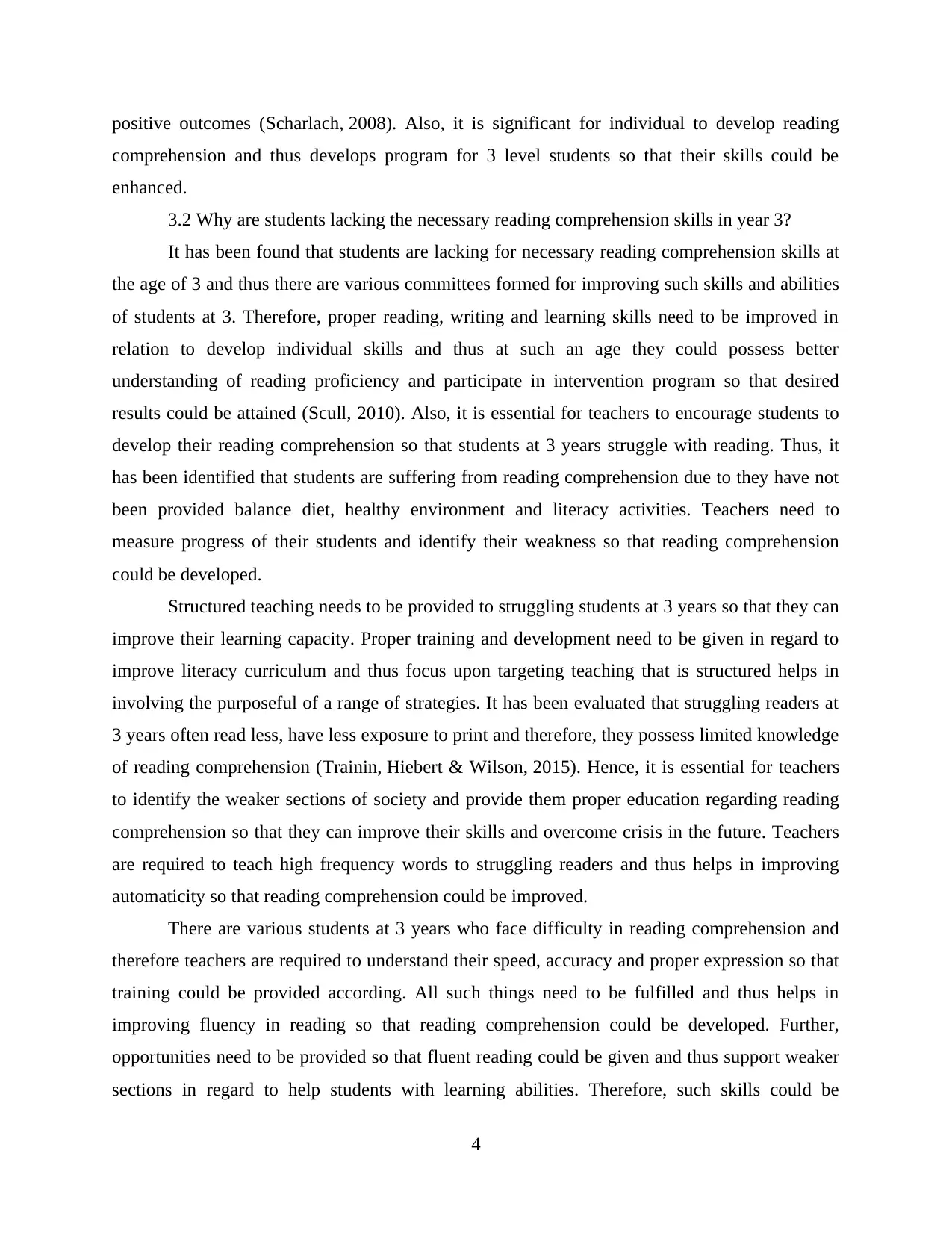
positive outcomes (Scharlach, 2008). Also, it is significant for individual to develop reading
comprehension and thus develops program for 3 level students so that their skills could be
enhanced.
3.2 Why are students lacking the necessary reading comprehension skills in year 3?
It has been found that students are lacking for necessary reading comprehension skills at
the age of 3 and thus there are various committees formed for improving such skills and abilities
of students at 3. Therefore, proper reading, writing and learning skills need to be improved in
relation to develop individual skills and thus at such an age they could possess better
understanding of reading proficiency and participate in intervention program so that desired
results could be attained (Scull, 2010). Also, it is essential for teachers to encourage students to
develop their reading comprehension so that students at 3 years struggle with reading. Thus, it
has been identified that students are suffering from reading comprehension due to they have not
been provided balance diet, healthy environment and literacy activities. Teachers need to
measure progress of their students and identify their weakness so that reading comprehension
could be developed.
Structured teaching needs to be provided to struggling students at 3 years so that they can
improve their learning capacity. Proper training and development need to be given in regard to
improve literacy curriculum and thus focus upon targeting teaching that is structured helps in
involving the purposeful of a range of strategies. It has been evaluated that struggling readers at
3 years often read less, have less exposure to print and therefore, they possess limited knowledge
of reading comprehension (Trainin, Hiebert & Wilson, 2015). Hence, it is essential for teachers
to identify the weaker sections of society and provide them proper education regarding reading
comprehension so that they can improve their skills and overcome crisis in the future. Teachers
are required to teach high frequency words to struggling readers and thus helps in improving
automaticity so that reading comprehension could be improved.
There are various students at 3 years who face difficulty in reading comprehension and
therefore teachers are required to understand their speed, accuracy and proper expression so that
training could be provided according. All such things need to be fulfilled and thus helps in
improving fluency in reading so that reading comprehension could be developed. Further,
opportunities need to be provided so that fluent reading could be given and thus support weaker
sections in regard to help students with learning abilities. Therefore, such skills could be
4
comprehension and thus develops program for 3 level students so that their skills could be
enhanced.
3.2 Why are students lacking the necessary reading comprehension skills in year 3?
It has been found that students are lacking for necessary reading comprehension skills at
the age of 3 and thus there are various committees formed for improving such skills and abilities
of students at 3. Therefore, proper reading, writing and learning skills need to be improved in
relation to develop individual skills and thus at such an age they could possess better
understanding of reading proficiency and participate in intervention program so that desired
results could be attained (Scull, 2010). Also, it is essential for teachers to encourage students to
develop their reading comprehension so that students at 3 years struggle with reading. Thus, it
has been identified that students are suffering from reading comprehension due to they have not
been provided balance diet, healthy environment and literacy activities. Teachers need to
measure progress of their students and identify their weakness so that reading comprehension
could be developed.
Structured teaching needs to be provided to struggling students at 3 years so that they can
improve their learning capacity. Proper training and development need to be given in regard to
improve literacy curriculum and thus focus upon targeting teaching that is structured helps in
involving the purposeful of a range of strategies. It has been evaluated that struggling readers at
3 years often read less, have less exposure to print and therefore, they possess limited knowledge
of reading comprehension (Trainin, Hiebert & Wilson, 2015). Hence, it is essential for teachers
to identify the weaker sections of society and provide them proper education regarding reading
comprehension so that they can improve their skills and overcome crisis in the future. Teachers
are required to teach high frequency words to struggling readers and thus helps in improving
automaticity so that reading comprehension could be improved.
There are various students at 3 years who face difficulty in reading comprehension and
therefore teachers are required to understand their speed, accuracy and proper expression so that
training could be provided according. All such things need to be fulfilled and thus helps in
improving fluency in reading so that reading comprehension could be developed. Further,
opportunities need to be provided so that fluent reading could be given and thus support weaker
sections in regard to help students with learning abilities. Therefore, such skills could be
4
⊘ This is a preview!⊘
Do you want full access?
Subscribe today to unlock all pages.

Trusted by 1+ million students worldwide
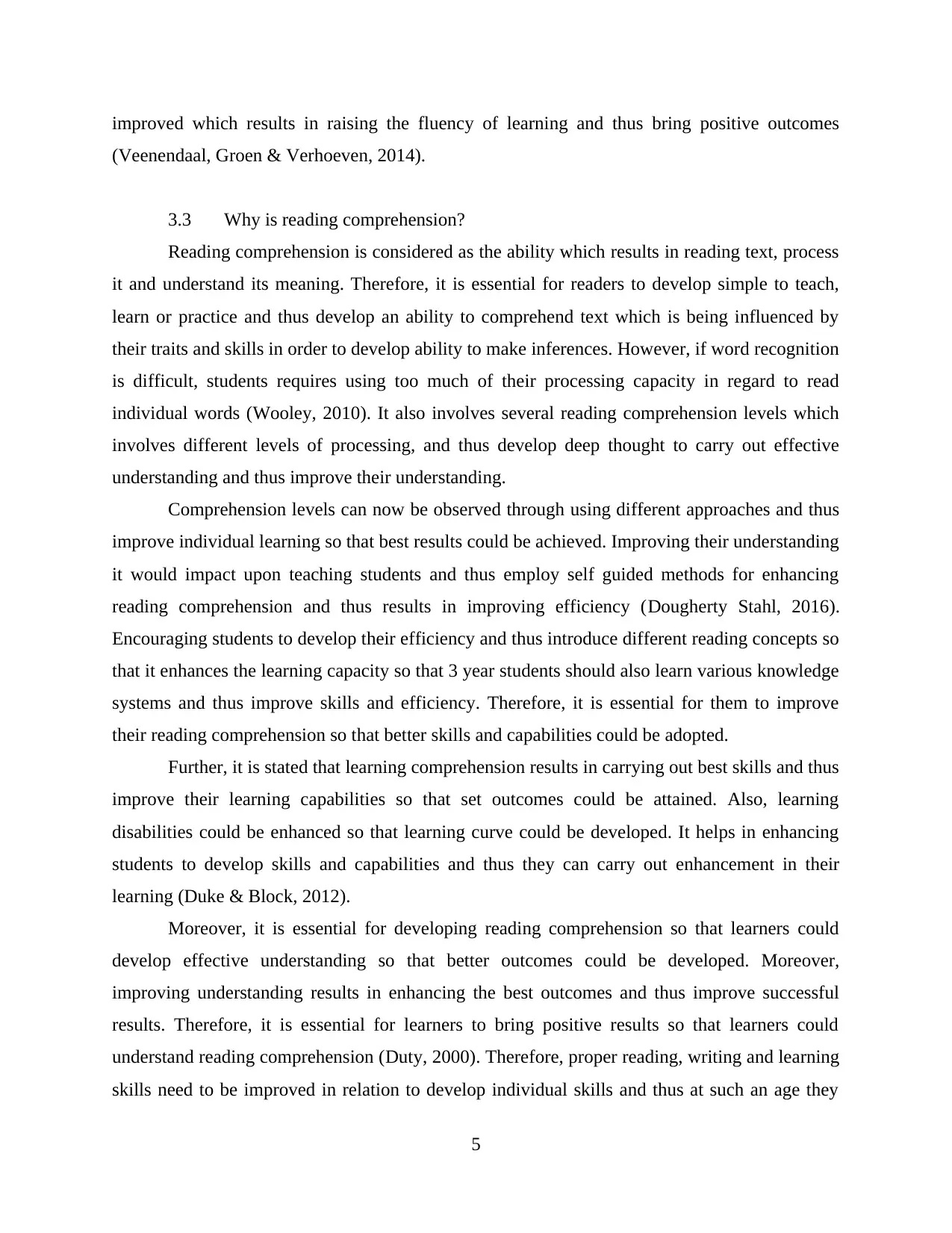
improved which results in raising the fluency of learning and thus bring positive outcomes
(Veenendaal, Groen & Verhoeven, 2014).
3.3 Why is reading comprehension?
Reading comprehension is considered as the ability which results in reading text, process
it and understand its meaning. Therefore, it is essential for readers to develop simple to teach,
learn or practice and thus develop an ability to comprehend text which is being influenced by
their traits and skills in order to develop ability to make inferences. However, if word recognition
is difficult, students requires using too much of their processing capacity in regard to read
individual words (Wooley, 2010). It also involves several reading comprehension levels which
involves different levels of processing, and thus develop deep thought to carry out effective
understanding and thus improve their understanding.
Comprehension levels can now be observed through using different approaches and thus
improve individual learning so that best results could be achieved. Improving their understanding
it would impact upon teaching students and thus employ self guided methods for enhancing
reading comprehension and thus results in improving efficiency (Dougherty Stahl, 2016).
Encouraging students to develop their efficiency and thus introduce different reading concepts so
that it enhances the learning capacity so that 3 year students should also learn various knowledge
systems and thus improve skills and efficiency. Therefore, it is essential for them to improve
their reading comprehension so that better skills and capabilities could be adopted.
Further, it is stated that learning comprehension results in carrying out best skills and thus
improve their learning capabilities so that set outcomes could be attained. Also, learning
disabilities could be enhanced so that learning curve could be developed. It helps in enhancing
students to develop skills and capabilities and thus they can carry out enhancement in their
learning (Duke & Block, 2012).
Moreover, it is essential for developing reading comprehension so that learners could
develop effective understanding so that better outcomes could be developed. Moreover,
improving understanding results in enhancing the best outcomes and thus improve successful
results. Therefore, it is essential for learners to bring positive results so that learners could
understand reading comprehension (Duty, 2000). Therefore, proper reading, writing and learning
skills need to be improved in relation to develop individual skills and thus at such an age they
5
(Veenendaal, Groen & Verhoeven, 2014).
3.3 Why is reading comprehension?
Reading comprehension is considered as the ability which results in reading text, process
it and understand its meaning. Therefore, it is essential for readers to develop simple to teach,
learn or practice and thus develop an ability to comprehend text which is being influenced by
their traits and skills in order to develop ability to make inferences. However, if word recognition
is difficult, students requires using too much of their processing capacity in regard to read
individual words (Wooley, 2010). It also involves several reading comprehension levels which
involves different levels of processing, and thus develop deep thought to carry out effective
understanding and thus improve their understanding.
Comprehension levels can now be observed through using different approaches and thus
improve individual learning so that best results could be achieved. Improving their understanding
it would impact upon teaching students and thus employ self guided methods for enhancing
reading comprehension and thus results in improving efficiency (Dougherty Stahl, 2016).
Encouraging students to develop their efficiency and thus introduce different reading concepts so
that it enhances the learning capacity so that 3 year students should also learn various knowledge
systems and thus improve skills and efficiency. Therefore, it is essential for them to improve
their reading comprehension so that better skills and capabilities could be adopted.
Further, it is stated that learning comprehension results in carrying out best skills and thus
improve their learning capabilities so that set outcomes could be attained. Also, learning
disabilities could be enhanced so that learning curve could be developed. It helps in enhancing
students to develop skills and capabilities and thus they can carry out enhancement in their
learning (Duke & Block, 2012).
Moreover, it is essential for developing reading comprehension so that learners could
develop effective understanding so that better outcomes could be developed. Moreover,
improving understanding results in enhancing the best outcomes and thus improve successful
results. Therefore, it is essential for learners to bring positive results so that learners could
understand reading comprehension (Duty, 2000). Therefore, proper reading, writing and learning
skills need to be improved in relation to develop individual skills and thus at such an age they
5
Paraphrase This Document
Need a fresh take? Get an instant paraphrase of this document with our AI Paraphraser
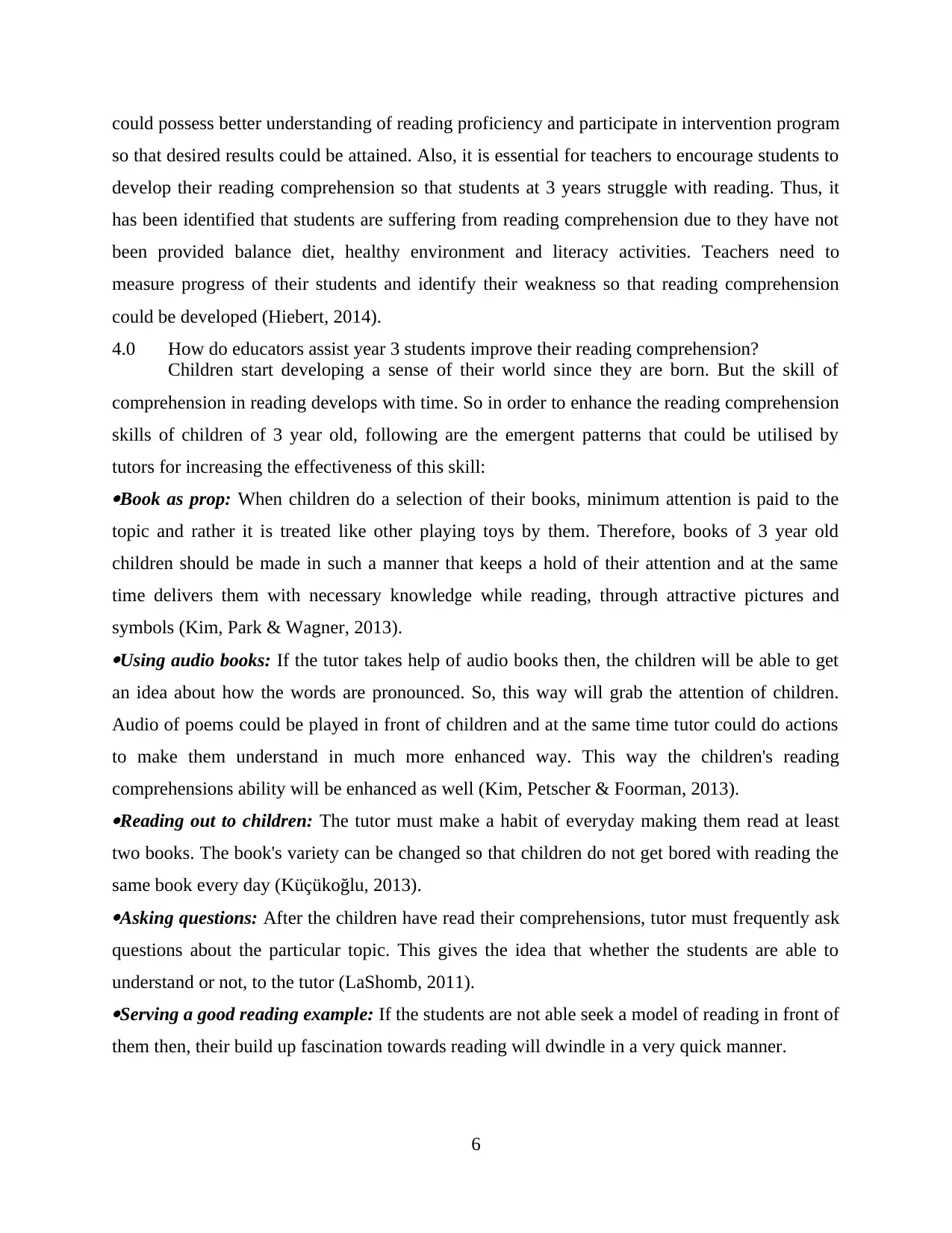
could possess better understanding of reading proficiency and participate in intervention program
so that desired results could be attained. Also, it is essential for teachers to encourage students to
develop their reading comprehension so that students at 3 years struggle with reading. Thus, it
has been identified that students are suffering from reading comprehension due to they have not
been provided balance diet, healthy environment and literacy activities. Teachers need to
measure progress of their students and identify their weakness so that reading comprehension
could be developed (Hiebert, 2014).
4.0 How do educators assist year 3 students improve their reading comprehension?
Children start developing a sense of their world since they are born. But the skill of
comprehension in reading develops with time. So in order to enhance the reading comprehension
skills of children of 3 year old, following are the emergent patterns that could be utilised by
tutors for increasing the effectiveness of this skill:Book as prop: When children do a selection of their books, minimum attention is paid to the
topic and rather it is treated like other playing toys by them. Therefore, books of 3 year old
children should be made in such a manner that keeps a hold of their attention and at the same
time delivers them with necessary knowledge while reading, through attractive pictures and
symbols (Kim, Park & Wagner, 2013).Using audio books: If the tutor takes help of audio books then, the children will be able to get
an idea about how the words are pronounced. So, this way will grab the attention of children.
Audio of poems could be played in front of children and at the same time tutor could do actions
to make them understand in much more enhanced way. This way the children's reading
comprehensions ability will be enhanced as well (Kim, Petscher & Foorman, 2013).Reading out to children: The tutor must make a habit of everyday making them read at least
two books. The book's variety can be changed so that children do not get bored with reading the
same book every day (Küçükoğlu, 2013).Asking questions: After the children have read their comprehensions, tutor must frequently ask
questions about the particular topic. This gives the idea that whether the students are able to
understand or not, to the tutor (LaShomb, 2011).Serving a good reading example: If the students are not able seek a model of reading in front of
them then, their build up fascination towards reading will dwindle in a very quick manner.
6
so that desired results could be attained. Also, it is essential for teachers to encourage students to
develop their reading comprehension so that students at 3 years struggle with reading. Thus, it
has been identified that students are suffering from reading comprehension due to they have not
been provided balance diet, healthy environment and literacy activities. Teachers need to
measure progress of their students and identify their weakness so that reading comprehension
could be developed (Hiebert, 2014).
4.0 How do educators assist year 3 students improve their reading comprehension?
Children start developing a sense of their world since they are born. But the skill of
comprehension in reading develops with time. So in order to enhance the reading comprehension
skills of children of 3 year old, following are the emergent patterns that could be utilised by
tutors for increasing the effectiveness of this skill:Book as prop: When children do a selection of their books, minimum attention is paid to the
topic and rather it is treated like other playing toys by them. Therefore, books of 3 year old
children should be made in such a manner that keeps a hold of their attention and at the same
time delivers them with necessary knowledge while reading, through attractive pictures and
symbols (Kim, Park & Wagner, 2013).Using audio books: If the tutor takes help of audio books then, the children will be able to get
an idea about how the words are pronounced. So, this way will grab the attention of children.
Audio of poems could be played in front of children and at the same time tutor could do actions
to make them understand in much more enhanced way. This way the children's reading
comprehensions ability will be enhanced as well (Kim, Petscher & Foorman, 2013).Reading out to children: The tutor must make a habit of everyday making them read at least
two books. The book's variety can be changed so that children do not get bored with reading the
same book every day (Küçükoğlu, 2013).Asking questions: After the children have read their comprehensions, tutor must frequently ask
questions about the particular topic. This gives the idea that whether the students are able to
understand or not, to the tutor (LaShomb, 2011).Serving a good reading example: If the students are not able seek a model of reading in front of
them then, their build up fascination towards reading will dwindle in a very quick manner.
6
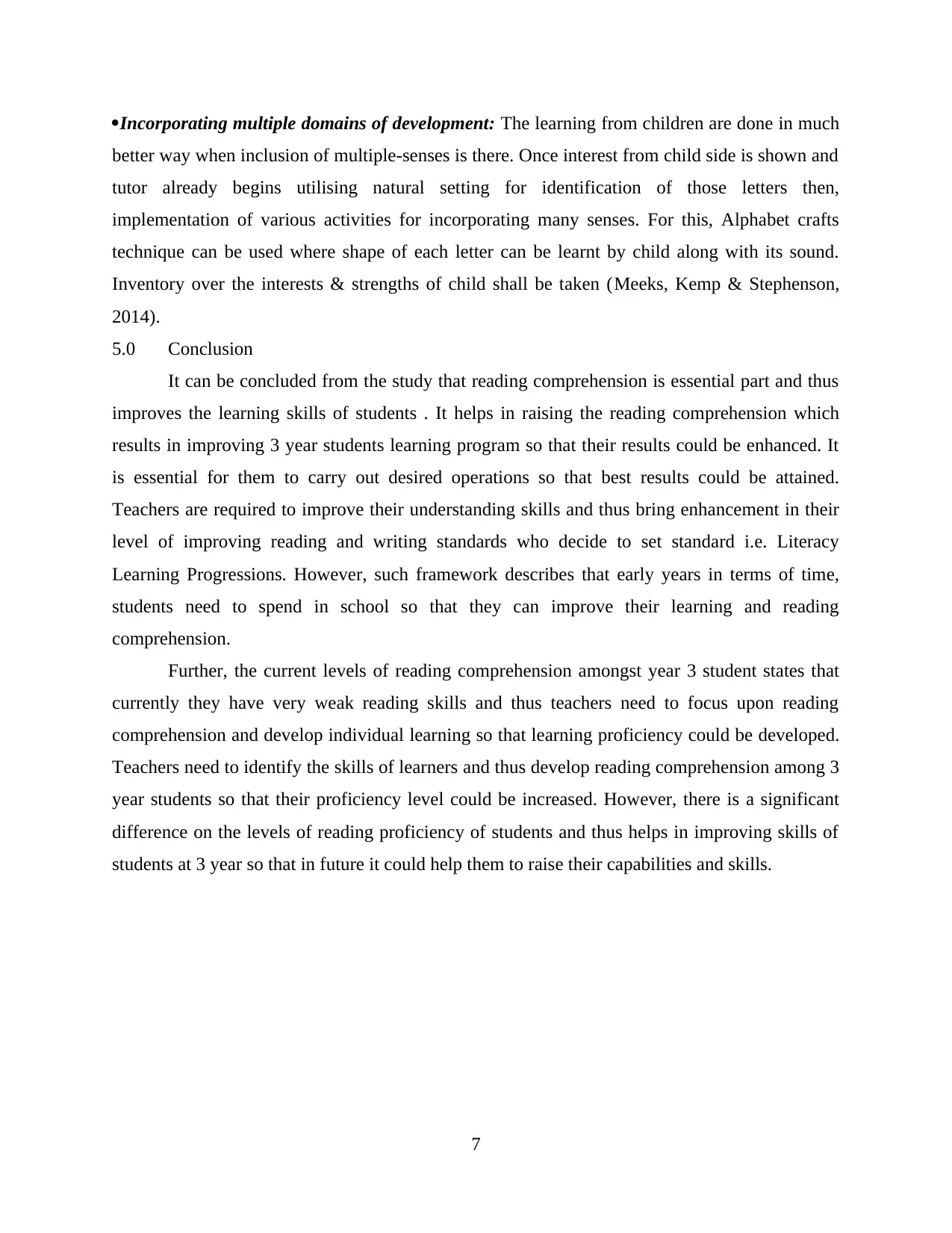
Incorporating multiple domains of development: The learning from children are done in much
better way when inclusion of multiple-senses is there. Once interest from child side is shown and
tutor already begins utilising natural setting for identification of those letters then,
implementation of various activities for incorporating many senses. For this, Alphabet crafts
technique can be used where shape of each letter can be learnt by child along with its sound.
Inventory over the interests & strengths of child shall be taken (Meeks, Kemp & Stephenson,
2014).
5.0 Conclusion
It can be concluded from the study that reading comprehension is essential part and thus
improves the learning skills of students . It helps in raising the reading comprehension which
results in improving 3 year students learning program so that their results could be enhanced. It
is essential for them to carry out desired operations so that best results could be attained.
Teachers are required to improve their understanding skills and thus bring enhancement in their
level of improving reading and writing standards who decide to set standard i.e. Literacy
Learning Progressions. However, such framework describes that early years in terms of time,
students need to spend in school so that they can improve their learning and reading
comprehension.
Further, the current levels of reading comprehension amongst year 3 student states that
currently they have very weak reading skills and thus teachers need to focus upon reading
comprehension and develop individual learning so that learning proficiency could be developed.
Teachers need to identify the skills of learners and thus develop reading comprehension among 3
year students so that their proficiency level could be increased. However, there is a significant
difference on the levels of reading proficiency of students and thus helps in improving skills of
students at 3 year so that in future it could help them to raise their capabilities and skills.
7
better way when inclusion of multiple-senses is there. Once interest from child side is shown and
tutor already begins utilising natural setting for identification of those letters then,
implementation of various activities for incorporating many senses. For this, Alphabet crafts
technique can be used where shape of each letter can be learnt by child along with its sound.
Inventory over the interests & strengths of child shall be taken (Meeks, Kemp & Stephenson,
2014).
5.0 Conclusion
It can be concluded from the study that reading comprehension is essential part and thus
improves the learning skills of students . It helps in raising the reading comprehension which
results in improving 3 year students learning program so that their results could be enhanced. It
is essential for them to carry out desired operations so that best results could be attained.
Teachers are required to improve their understanding skills and thus bring enhancement in their
level of improving reading and writing standards who decide to set standard i.e. Literacy
Learning Progressions. However, such framework describes that early years in terms of time,
students need to spend in school so that they can improve their learning and reading
comprehension.
Further, the current levels of reading comprehension amongst year 3 student states that
currently they have very weak reading skills and thus teachers need to focus upon reading
comprehension and develop individual learning so that learning proficiency could be developed.
Teachers need to identify the skills of learners and thus develop reading comprehension among 3
year students so that their proficiency level could be increased. However, there is a significant
difference on the levels of reading proficiency of students and thus helps in improving skills of
students at 3 year so that in future it could help them to raise their capabilities and skills.
7
⊘ This is a preview!⊘
Do you want full access?
Subscribe today to unlock all pages.

Trusted by 1+ million students worldwide

REFERENCES
Books and Journals
8
Books and Journals
8
Paraphrase This Document
Need a fresh take? Get an instant paraphrase of this document with our AI Paraphraser
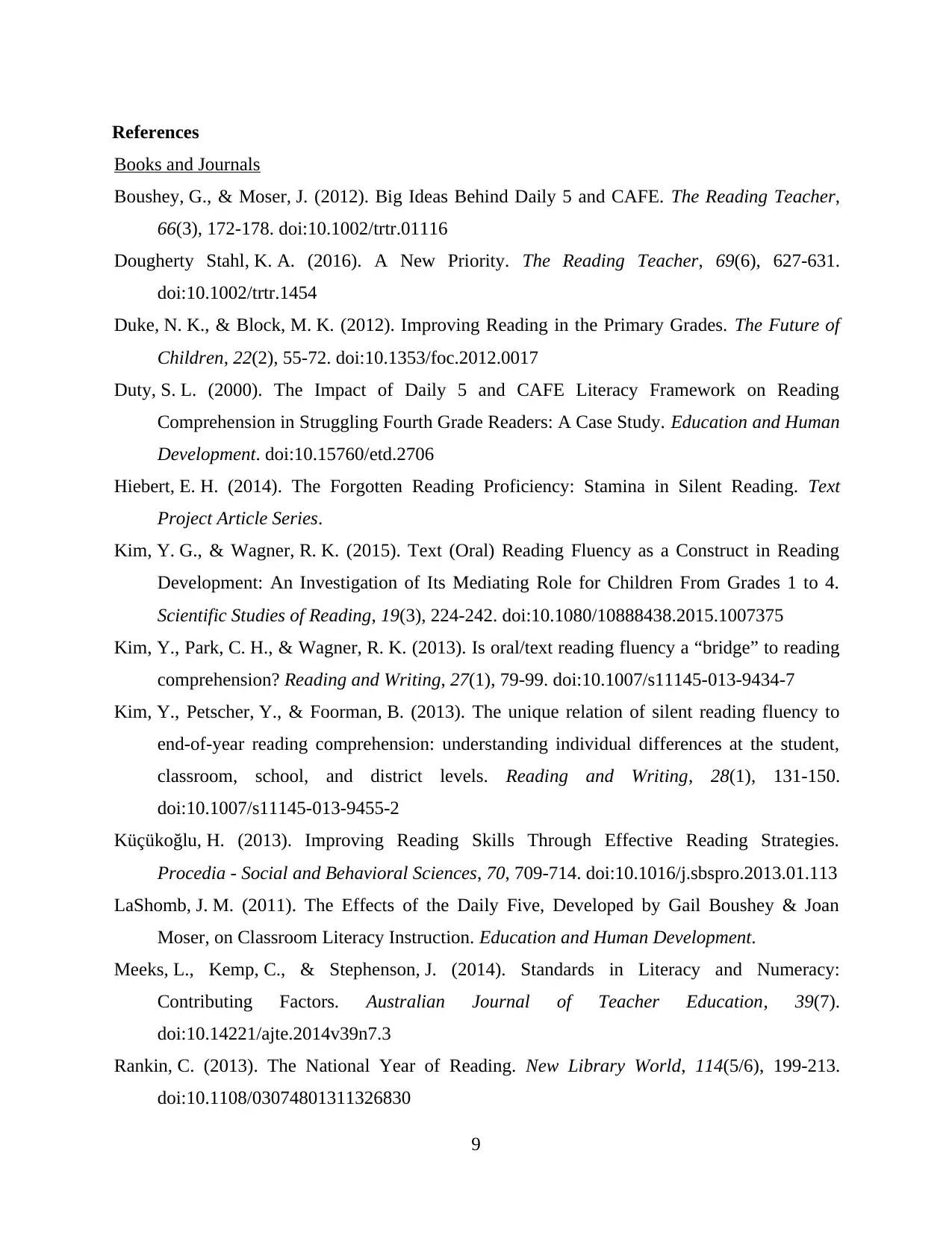
References
Books and Journals
Boushey, G., & Moser, J. (2012). Big Ideas Behind Daily 5 and CAFE. The Reading Teacher,
66(3), 172-178. doi:10.1002/trtr.01116
Dougherty Stahl, K. A. (2016). A New Priority. The Reading Teacher, 69(6), 627-631.
doi:10.1002/trtr.1454
Duke, N. K., & Block, M. K. (2012). Improving Reading in the Primary Grades. The Future of
Children, 22(2), 55-72. doi:10.1353/foc.2012.0017
Duty, S. L. (2000). The Impact of Daily 5 and CAFE Literacy Framework on Reading
Comprehension in Struggling Fourth Grade Readers: A Case Study. Education and Human
Development. doi:10.15760/etd.2706
Hiebert, E. H. (2014). The Forgotten Reading Proficiency: Stamina in Silent Reading. Text
Project Article Series.
Kim, Y. G., & Wagner, R. K. (2015). Text (Oral) Reading Fluency as a Construct in Reading
Development: An Investigation of Its Mediating Role for Children From Grades 1 to 4.
Scientific Studies of Reading, 19(3), 224-242. doi:10.1080/10888438.2015.1007375
Kim, Y., Park, C. H., & Wagner, R. K. (2013). Is oral/text reading fluency a “bridge” to reading
comprehension? Reading and Writing, 27(1), 79-99. doi:10.1007/s11145-013-9434-7
Kim, Y., Petscher, Y., & Foorman, B. (2013). The unique relation of silent reading fluency to
end-of-year reading comprehension: understanding individual differences at the student,
classroom, school, and district levels. Reading and Writing, 28(1), 131-150.
doi:10.1007/s11145-013-9455-2
Küçükoğlu, H. (2013). Improving Reading Skills Through Effective Reading Strategies.
Procedia - Social and Behavioral Sciences, 70, 709-714. doi:10.1016/j.sbspro.2013.01.113
LaShomb, J. M. (2011). The Effects of the Daily Five, Developed by Gail Boushey & Joan
Moser, on Classroom Literacy Instruction. Education and Human Development.
Meeks, L., Kemp, C., & Stephenson, J. (2014). Standards in Literacy and Numeracy:
Contributing Factors. Australian Journal of Teacher Education, 39(7).
doi:10.14221/ajte.2014v39n7.3
Rankin, C. (2013). The National Year of Reading. New Library World, 114(5/6), 199-213.
doi:10.1108/03074801311326830
9
Books and Journals
Boushey, G., & Moser, J. (2012). Big Ideas Behind Daily 5 and CAFE. The Reading Teacher,
66(3), 172-178. doi:10.1002/trtr.01116
Dougherty Stahl, K. A. (2016). A New Priority. The Reading Teacher, 69(6), 627-631.
doi:10.1002/trtr.1454
Duke, N. K., & Block, M. K. (2012). Improving Reading in the Primary Grades. The Future of
Children, 22(2), 55-72. doi:10.1353/foc.2012.0017
Duty, S. L. (2000). The Impact of Daily 5 and CAFE Literacy Framework on Reading
Comprehension in Struggling Fourth Grade Readers: A Case Study. Education and Human
Development. doi:10.15760/etd.2706
Hiebert, E. H. (2014). The Forgotten Reading Proficiency: Stamina in Silent Reading. Text
Project Article Series.
Kim, Y. G., & Wagner, R. K. (2015). Text (Oral) Reading Fluency as a Construct in Reading
Development: An Investigation of Its Mediating Role for Children From Grades 1 to 4.
Scientific Studies of Reading, 19(3), 224-242. doi:10.1080/10888438.2015.1007375
Kim, Y., Park, C. H., & Wagner, R. K. (2013). Is oral/text reading fluency a “bridge” to reading
comprehension? Reading and Writing, 27(1), 79-99. doi:10.1007/s11145-013-9434-7
Kim, Y., Petscher, Y., & Foorman, B. (2013). The unique relation of silent reading fluency to
end-of-year reading comprehension: understanding individual differences at the student,
classroom, school, and district levels. Reading and Writing, 28(1), 131-150.
doi:10.1007/s11145-013-9455-2
Küçükoğlu, H. (2013). Improving Reading Skills Through Effective Reading Strategies.
Procedia - Social and Behavioral Sciences, 70, 709-714. doi:10.1016/j.sbspro.2013.01.113
LaShomb, J. M. (2011). The Effects of the Daily Five, Developed by Gail Boushey & Joan
Moser, on Classroom Literacy Instruction. Education and Human Development.
Meeks, L., Kemp, C., & Stephenson, J. (2014). Standards in Literacy and Numeracy:
Contributing Factors. Australian Journal of Teacher Education, 39(7).
doi:10.14221/ajte.2014v39n7.3
Rankin, C. (2013). The National Year of Reading. New Library World, 114(5/6), 199-213.
doi:10.1108/03074801311326830
9
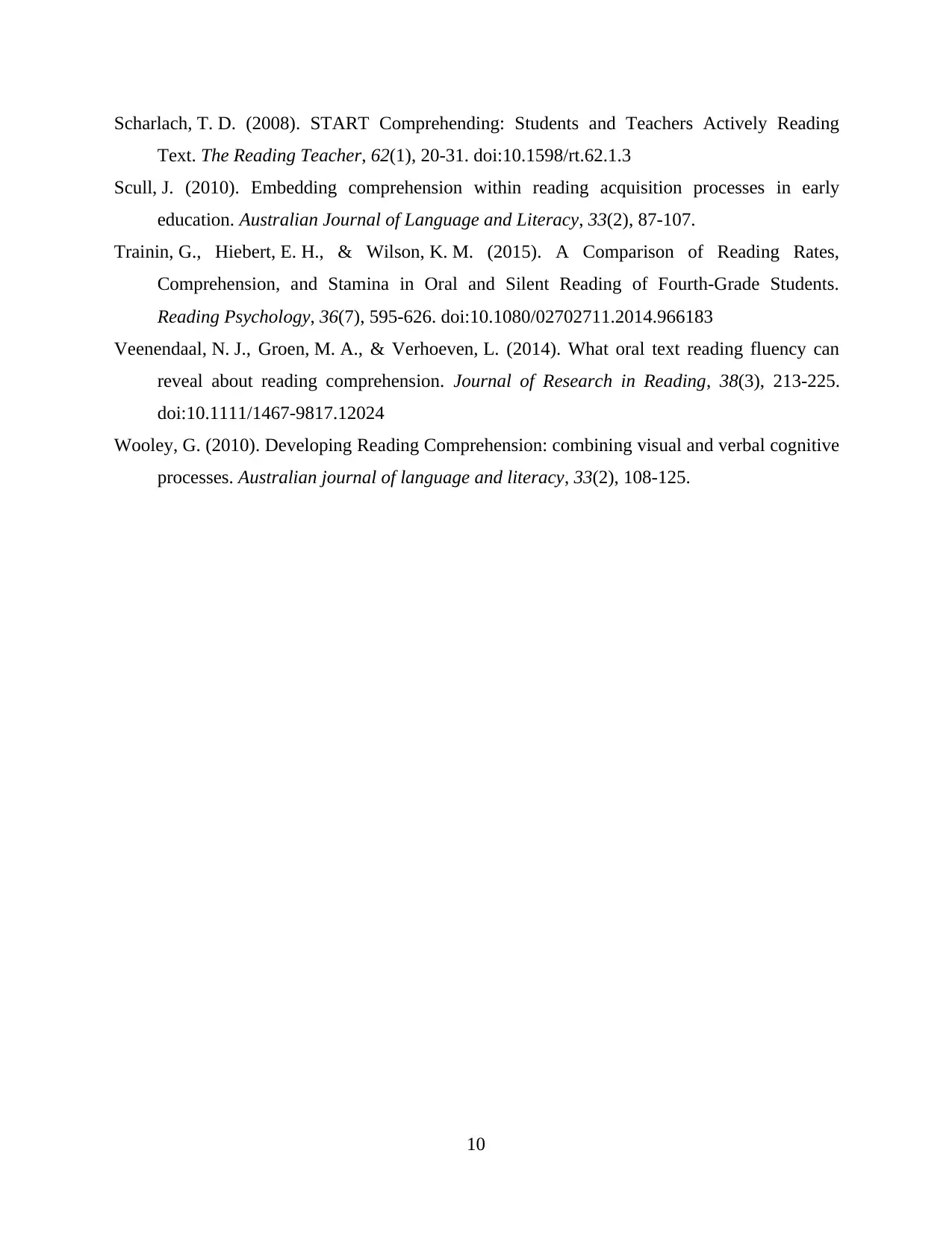
Scharlach, T. D. (2008). START Comprehending: Students and Teachers Actively Reading
Text. The Reading Teacher, 62(1), 20-31. doi:10.1598/rt.62.1.3
Scull, J. (2010). Embedding comprehension within reading acquisition processes in early
education. Australian Journal of Language and Literacy, 33(2), 87-107.
Trainin, G., Hiebert, E. H., & Wilson, K. M. (2015). A Comparison of Reading Rates,
Comprehension, and Stamina in Oral and Silent Reading of Fourth-Grade Students.
Reading Psychology, 36(7), 595-626. doi:10.1080/02702711.2014.966183
Veenendaal, N. J., Groen, M. A., & Verhoeven, L. (2014). What oral text reading fluency can
reveal about reading comprehension. Journal of Research in Reading, 38(3), 213-225.
doi:10.1111/1467-9817.12024
Wooley, G. (2010). Developing Reading Comprehension: combining visual and verbal cognitive
processes. Australian journal of language and literacy, 33(2), 108-125.
10
Text. The Reading Teacher, 62(1), 20-31. doi:10.1598/rt.62.1.3
Scull, J. (2010). Embedding comprehension within reading acquisition processes in early
education. Australian Journal of Language and Literacy, 33(2), 87-107.
Trainin, G., Hiebert, E. H., & Wilson, K. M. (2015). A Comparison of Reading Rates,
Comprehension, and Stamina in Oral and Silent Reading of Fourth-Grade Students.
Reading Psychology, 36(7), 595-626. doi:10.1080/02702711.2014.966183
Veenendaal, N. J., Groen, M. A., & Verhoeven, L. (2014). What oral text reading fluency can
reveal about reading comprehension. Journal of Research in Reading, 38(3), 213-225.
doi:10.1111/1467-9817.12024
Wooley, G. (2010). Developing Reading Comprehension: combining visual and verbal cognitive
processes. Australian journal of language and literacy, 33(2), 108-125.
10
⊘ This is a preview!⊘
Do you want full access?
Subscribe today to unlock all pages.

Trusted by 1+ million students worldwide
1 out of 12
Related Documents
Your All-in-One AI-Powered Toolkit for Academic Success.
+13062052269
info@desklib.com
Available 24*7 on WhatsApp / Email
![[object Object]](/_next/static/media/star-bottom.7253800d.svg)
Unlock your academic potential
Copyright © 2020–2025 A2Z Services. All Rights Reserved. Developed and managed by ZUCOL.





